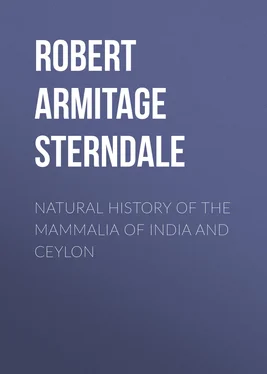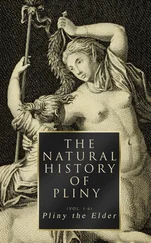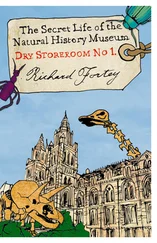Robert Armitage Sterndale - Natural History of the Mammalia of India and Ceylon
Здесь есть возможность читать онлайн «Robert Armitage Sterndale - Natural History of the Mammalia of India and Ceylon» — ознакомительный отрывок электронной книги совершенно бесплатно, а после прочтения отрывка купить полную версию. В некоторых случаях можно слушать аудио, скачать через торрент в формате fb2 и присутствует краткое содержание. Жанр: foreign_edu, Биология, на английском языке. Описание произведения, (предисловие) а так же отзывы посетителей доступны на портале библиотеки ЛибКат.
- Название:Natural History of the Mammalia of India and Ceylon
- Автор:
- Жанр:
- Год:неизвестен
- ISBN:нет данных
- Рейтинг книги:5 / 5. Голосов: 1
-
Избранное:Добавить в избранное
- Отзывы:
-
Ваша оценка:
- 100
- 1
- 2
- 3
- 4
- 5
Natural History of the Mammalia of India and Ceylon: краткое содержание, описание и аннотация
Предлагаем к чтению аннотацию, описание, краткое содержание или предисловие (зависит от того, что написал сам автор книги «Natural History of the Mammalia of India and Ceylon»). Если вы не нашли необходимую информацию о книге — напишите в комментариях, мы постараемся отыскать её.
Natural History of the Mammalia of India and Ceylon — читать онлайн ознакомительный отрывок
Ниже представлен текст книги, разбитый по страницам. Система сохранения места последней прочитанной страницы, позволяет с удобством читать онлайн бесплатно книгу «Natural History of the Mammalia of India and Ceylon», без необходимости каждый раз заново искать на чём Вы остановились. Поставьте закладку, и сможете в любой момент перейти на страницу, на которой закончили чтение.
Интервал:
Закладка:
Dr. E. Coues, in his monograph on the North American Mustelidæ, gives the following interesting information regarding the number of skins of various species sold by the Hudson's Bay Company in London during the century 1769-1868:—
Sables, 1,240,511; otters, 674,027; wolverenes, 68,694; minks, 1,507,240; skunks, 218,653; badgers, 275,302; sea otters, 5349. In 1868, which appears to have been a prosperous year, the Company sold: Sables, 106,254; otters, 14,966; wolverenes, 1104; minks, 73,473; skunks, 6298; badgers, 1551; sea otters, 123. 8
When one considers the number of those whose skins are damaged and cast aside, the number that fall victims to larger predatory animals, and the operations of disease, from which no animals, small or great, are free, we may form some idea of the immense multitude of these little creatures.
The ordinary divisions of the restricted Mustelidæ are the Martens ( Martes ), Pole-cats ( Putorius ), and Weasels ( Mustela ), but Gray has further subdivided them chiefly on the characteristics of the feet.
The Martens have four more teeth than the rest, which are distinguished as follows:—
Putorius .—Short ovate head; feet very hairy, especially between the pads; body stout; underside blackish.
Mustela .—Narrow, elongated head; feet very hairy between the pads; slender body; under-side yellow or white.
Vison .—Head elongate, narrow; feet slightly hairy; pads exposed; body rather slender; under-side same colour as upper.
Gymnopus .—Head elongate, narrow; feet rather naked, bald beneath, between, and rather behind the pads; toes largely webbed; soles hairy behind; body slender.
It is doubtful whether these distinctions are of sufficient importance to warrant so much subdivision; and unnecessary multiplication of genera is a thing to be avoided as much as possible.
A more or less arboreal group of larger size, and possibly less sanguinary habits than the weasels, although in this respect I do not think there is much difference. The tail is longer, though not so long as the head and body, and it is bushy; the fur is fine and in general highly prized; the dentition differs from the typical Mustela in having four more teeth and an additional false molar on either side in each jaw; and the inner side of the carnassial or flesh tooth has a tubercle which is not present in the weasels; head elongate; feet very hairy; space between the pads hairy, often covering them from sight, except in the case of Martes flavigula
Конец ознакомительного фрагмента.
Текст предоставлен ООО «ЛитРес».
Прочитайте эту книгу целиком, на ЛитРес.
Безопасно оплатить книгу можно банковской картой Visa, MasterCard, Maestro, со счета мобильного телефона, с платежного терминала, в салоне МТС или Связной, через PayPal, WebMoney, Яндекс.Деньги, QIWI Кошелек, бонусными картами или другим удобным Вам способом.
1
There has been lately exhibited in London a child from Borneo which has several points in common with the monkey—hairy face and arms, the hair on the fore-arm being reversed, as in the apes.
2
Since the above was written there has been published in the 'Journal of the Anthropological Institute,' vol. xii., a most interesting and exhaustive paper on these people by Mr. E. H. Man, F.R.G.S., giving them credit for much intelligence.
3
There is an excellent coloured drawing by Wolf of these two Gibbons in the 'Proceedings of the Zoological Society,' 1870, page 86, from which I have partly adapted the accompanying sketch.
4
The legend, with native picture, is given in Wilkin's 'Hindoo Mythology.'
5
Mr. J. Cockburn, of the Imperial Museum, has, since I wrote about the preceding species, given me some interesting information regarding the geographical distribution of Presbytes entellus and Hylobates hooluck . He says: "The latter has never been known to occur on the north bank of the Brahmaputra, though swarming in the forests at the very water's edge on the south bank. The entellus monkey is also not found on the north bank of the Ganges, and attempts at its introduction have repeatedly failed." P. schistaceus replaces it in the Sub-Himalayan forests.
6
On referring to Mr. Sanderson's interesting book, 'Thirteen Years among the Wild Beasts of India,' and General Shakespear's 'Wild Sports,' I find that both those authors corroborate my assertion that the sloth bear is deficient in the sense of hearing. Captain Baldwin, however, thinks otherwise; but the evidence seems to be against him in this respect.
7
Since writing the above, the following letter appeared in The Asian of May 11, 1880:—
"SIR,—Mr. Sterndale, in the course of his interesting papers on the Mammalia of British India, remarks of Ursus Tibetanus , commonly known as the Himalayan Black Bear, that 'a wounded one will sometimes show fight, but in general it tries to escape.' This description is not, I think, quite correct. As it would lead one to suppose that this bear is not more savage than any other wild animal—the nature of most of the feræ being to try to escape when wounded, unless they see the hunter who has fired at them, when many will charge at once, and desperately. The Himalayan Black Bear will not only do this almost invariably , but often attacks men without any provocation whatever, and is altogether about the most fierce, vicious, dangerous brute to be met with either in the hills or plains of India. They inflict the most horrible wounds, chiefly with their paws, and generally—as Mr. Sterndale states—on the face and head. I have repeatedly met natives in the interior frightfully mutilated by encounters with the Black Bear, and cases in which Europeans have been killed by them are by no means uncommon. These brutes are totally different in their dispositions to the Brown Bear ( Ursus Isabellinus ), which, however desperately wounded, will never charge. I believe there is no case on record of a hunter being charged by a Brown Bear; or even of natives, under any circumstances, being attacked by one; whereas every one of your readers who has ever marched in the Himalayas must have come across many victims of the ferocity of Ursus Tibetanus . As I said before, this brute often, unwounded, attacks man without any provocation whatever. Two cases that I know of myself may not be without interest. An officer shooting near my camp was stalking some thar. He was getting close to them, when a Black Bear rushed out at him from behind a large rock on his right and above him. He was so intent on the thar, and the brute's rush was so sudden, that he had barely time to pull from the hip, but he was fortunate enough to kill the animal almost at his feet. I heard this from him on the morning after it happened. On another occasion, I was shooting in Chumba with a friend. One evening he encamped at a village, about which there was, as usual, a little cultivation on terraces, and a good many apricot-trees. Lower down the khud there was dense jungle. The villagers told us that a Black Bear had lately been regularly visiting these trees, and generally came out about dusk, so that if we would go down and wait, we should be pretty sure of a shot. We went, and took up positions behind trees, about 200 yards apart, each of us having a man from the village with us. Intervening jungle prevented us from seeing each other. I had not been at my post more than ten minutes when I was startled by loud shrieks and cries from the direction of my companion. No shot was fired, and the coolie with me said that the bear had killed some one. In less than a minute I had reached the spot where I had left my friend. He, and the man with him, had disappeared; but, guided by the shrieks, which still continued, I made my way into the thick cover in front of his post, and about fifty yards inside it, much to my relief, came upon him, rifle in hand, standing over the dead body of a man, over which two people—the coolie that had been with my friend and an old woman—were weeping, and shrieking loudly, 'Look out!' said he, as I came up, 'the bear has just killed this fellow!' The first thing to be done was to carry him out into the open. I helped to do this, and directly I touched him I felt that he was stone cold, and a further examination showed he must have been dead some hours. That he had been killed by a bear was also very evident. He was naked to the waist, and had been cutting grass. His bundle lay by him, and the long curved kind of sickle that the hillmen used to cut grass with was stuck in his girdle, showing that he had not had time to draw it to strike one blow in his defence. The mark of the bear's paw on his left side was quite distinct. This had felled him to the ground, and then the savage brute had given him one bite—no more, but that one had demolished almost the whole of the back of his head, and death must have been instantaneous. The man had apparently cut his load of grass, and was returning with it to the village, when he disturbed the bear, which attacked him at once. The old woman was his mother, and the coolie with J– some relation. Her son having been away all day, I suppose the old woman had gone to look for him. She found his body, as described, just below J–'s post, and at once set up a lamentation which brought the coolie, J–'s attendant, down to her, and J– following himself, thought at first that the man had been killed then and there. There was such a row kicked up that no bear came near the apricots that night, and the next day we had to march, as our leave was up. I have heard of many other cases of the Black Bear attacking without any provocation, and from what I know of the brute I quite believe them; and, after all, the animal is not worth shooting. Their skins are always poor and mangy, and generally so greasy that they are very difficult to keep until you can make them over to the dresser. The skin of the Snow or Brown Bear, on the other hand, particularly if shot early in the season, is a splendid trophy, and forms a most beautiful and luxurious rug, the fur being extremely soft, and several inches in depth.
Читать дальшеИнтервал:
Закладка:
Похожие книги на «Natural History of the Mammalia of India and Ceylon»
Представляем Вашему вниманию похожие книги на «Natural History of the Mammalia of India and Ceylon» списком для выбора. Мы отобрали схожую по названию и смыслу литературу в надежде предоставить читателям больше вариантов отыскать новые, интересные, ещё непрочитанные произведения.
Обсуждение, отзывы о книге «Natural History of the Mammalia of India and Ceylon» и просто собственные мнения читателей. Оставьте ваши комментарии, напишите, что Вы думаете о произведении, его смысле или главных героях. Укажите что конкретно понравилось, а что нет, и почему Вы так считаете.












